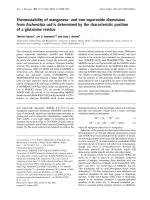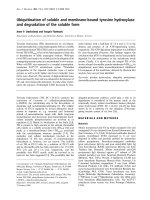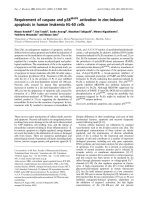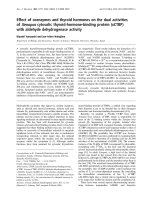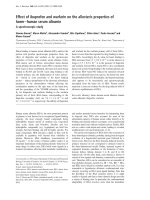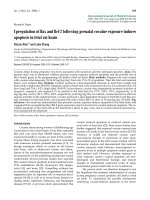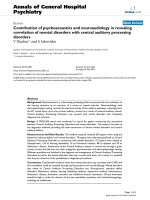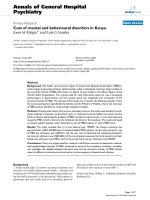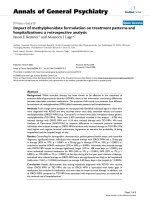Báo cáo y học: "Impact of cytokines and T lymphocytes upon osteoclast differentiation and function" pot
Bạn đang xem bản rút gọn của tài liệu. Xem và tải ngay bản đầy đủ của tài liệu tại đây (195.93 KB, 3 trang )
Page 1 of 3
(page number not for citation purposes)
Available online />Abstract
Historically, the osteoblast has been considered the master cell in
the control of osteoclast development and, therefore, bone
resorption. Now the interactions between cells of the immune
system and bone cells have redefined our thinking on the
regulation of bone resorption. Moreover, the crosstalk between
these cell types has special significance in inflammatory conditions
such as rheumatoid arthritis. This report highlights the contribution
that T lymphocytes make in regulating osteoclast formation and
bone resorption.
Rheumatoid arthritis, the most common chronic autoimmune
disease, ultimately presents with joint destruction as a
consequence of an inflammatory process. Whilst the
pathogenesis for onset of this disease is not understood, the
final steps in the process leading to bone destruction have
been recently resolved. It has been a long held view that
infiltrating synovial cells are responsible for juxta-articular
bone loss, although it is now clear that the osteoclast is the
only cell capable of resorbing bone. The recognition of this
exclusive role for the osteoclast in all pathologies involving
bone loss (osteoporosis, arthritis, periodontal disease) has
identified a single cell whose function can be modulated to
enhance or reduce bone loss [1].
The identification of the osteoclast and its role in bone
destruction permits targeted therapy to reduce its resorptive
capacity. Such therapies include the use of agents that can
interfere with receptor activator of NFκB ligand (RANKL), one
of the key cytokines promoting osteoclast differentiation. This
may be achieved through the use of recombinant Fc-
osteoprotegerin (Fc-OPG) or a humanised anti-RANKL
antibody (Denosumab) that is being developed by Amgen.
Both have demonstrated efficacy in preclinical models of
bone loss, with Denosumab progressing through clinical
trials; Fc-OPG was withdrawn from clinical trials due to
immune side effects. Other inhibitors of osteoclast activity
include the bisposhonates, c-src inhibitors, cathepsin K
inhibitors and inhibitors of the chloride channel CLC7 [2].
Notably, bisphosphonates have been successful in limiting
bone loss in rodent models of arthritis, although it should be
noted that the nitrogen-containing bisphosphonates (which
include aldronate, ibandronate, pamidronate and zoledronate)
enhance proliferation of γ/δ T lymphocytes, while non-
nitrogen-containing bisphosphonates (for example, clondronate)
do not [3]. Enhanced inflammation has been noted in rodent
models of arthritis when treated with zoledronate, raising a
cautionary note to evaluate the bone-protective effects versus
the potential of enhanced immune response with nitrogen-
containing bisphosphonates in inflammatory conditions.
The pro-resorptive roles of T lymphocytes
In the pathogenesis of rheumatoid arthritis, lymphocyte and
synovial cell expansion is observed. These occur prior to
bone destruction, suggesting that these cells may be
responsible for osteoclast formation and activation. RANKL
and macrophage-colony stimulating factor (M-CSF) are the
principal factors involved in the differentiation of the osteo-
clast (Figure 1) and RANKL is expressed by activated
T lymphocytes [1]; lymphocytes express soluble RANKL,
which may result from shedding of its membrane-bound form
or the secretion of an isoform of RANKL that may be
produced from an alternative mRNA transcript. In vitro, the
process of T cell activation can be recapitulated following
stimulation of cells with phenyl methyl acetate/concanavalin A
and engagement of the T cell receptor (Figure 1). Such
activated cells express RANKL and, importantly, support
osteoclast formation and activation. A second mechanism by
which T lymphocytes may support osteoclast formation
directly is as a consequence of IL-7 production, and this
appears to be mediated by a RANKL-independent process
Commentary
Impact of cytokines and T lymphocytes upon osteoclast
differentiation and function
Matthew T Gillespie
St Vincent’s Institute of Medical Research, Princes Street, Fitzroy 3065, Victoria, Australia
Corresponding author: Matthew T Gillespie,
Published: 21 March 2007 Arthritis Research & Therapy 2007, 9:103 (doi:10.1186/ar2141)
This article is online at />© 2007 BioMed Central Ltd
GM-CSF = granulocyte macrophage-colony stimulating factor; IFN = interferon; IL = interleukin; M-CSF = macrophage-colony stimulating factor;
OPG = osteoprotegerin; RANKL = receptor activator of NFκB ligand; sFRP = secreted Frizzled-related protein; TGF = transforming growth factor;
TNF = tumour necrosis factor.
Page 2 of 3
(page number not for citation purposes)
Arthritis Research & Therapy Vol 9 No 2 Gillespie
[4]. Finally, T lymphocytes express tumour necrosis factor
(TNF)-α and this acts in concert with RANKL to promote
osteoclast formation. The essential role of T lymphocyte-
derived RANKL in rodent models of arthritis has been
identified through adoptive transfer experiments that highlight
the essential contribution of T cells to bone loss.
In addition to the ability of T lymphocytes to directly support
osteoclastogenesis, T lymphocytes also secrete pro-
resorptive cytokines, including IL-1, IL-6 and IL-17, each of
which can stimulate RANKL expression by osteoblasts and
fibroblasts, permitting osteoclast formation by a contact-
dependent process (Figure 1) [1,2,4]; unlike T cells, there is
no convincing evidence that osteoblasts or fibroblasts
produce soluble RANKL. Notably, IL-17 production further
discriminates CD4
+
T cell populations, with the cells
producing it being designated as Th
17
cells. Th
17
cells also
express TNF, IL-6 and granulocyte macrophage-colony
stimulating factor (GM-CSF) and are responsive to IL-23,
which regulates their expansion and survival. The importance
of IL-17 and IL-23 in rheumatoid arthritis and other inflam-
matory diseases has been highlighted in studies using
knockout mice. IL-17 or IL-23 deficient mice were resistant to
experimental autoimmune encephalomyelitis and to collagen-
induced arthritis [5,6]. These roles suggest that Th
17
cells
function as important immunomodulators of osteoclastic bone
resorption [7].
T lymphocytes protecting against bone loss
In contrast to the pro-resorptive roles of T lymphocytes,
several other T cell-derived interleukins and cytokines have
the capacity to inhibit osteoclast formation and activity, and
these may be expressed by naïve or activated T cells (Figure 1).
GM-CSF, IL-3, IFN-γ, IFN-β, OPG, IL-4, IL-10, IL-13, osteo-
clast inhibitory lectin and secreted Frizzled-related proteins
(sFRPs) potently inhibit osteoclast formation (Figure 1) [2].
The molecules highlighted in Figure 1 are discussed below.
OPG acts as a decoy receptor to RANKL to limit its
biological action, while several of the other cytokines perturb
JAK/STAT signalling. It should be noted that GM-CSF has
dual functions depending upon the presence of RANKL.
When RANKL is absent, GM-CSF enhances progenitor
proliferation, thus promoting the total numbers of osteoclasts
when such progenitors are exposed to RANKL. However,
when RANKL and GM-CSF are co-administered to osteo-
clast progenitors, differentiation is favoured towards dendritic
cells and not osteoclasts, and this process is further
enhanced when IL-4 is additionally supplied. This lineage
switch between osteoclasts and dendritic cells has been
described in vitro, where cytokine delivery can be precisely
defined. The situation in vivo is less clear, and the local
concentrations of many cytokines and growth factors
undoubtedly influence differentiation pathways.
The Wnt pathway is essential for osteoblast differentiation,
and its central role in regulating bone mass is exemplified by
individuals with high bone mass phenotypes having activating
mutations in the Wnt pathway. Wnt signalling is also involved
in T cell development and osteoclastogenesis, and the secreted
Wnt decoy receptors sFRP-1 and sFRP-3 are able to inhibit
osteoclast formation; both of these Wnt antagonists are
expressed by T cells.
Finally, the C-type lectins CD69, osteoclast inhibitory lectin
and Nkrps, which are markers of activated T cells and are
expressed as membrane-bound molecules, also inhibit
osteoclastogenesis. Their mechanism of action is not known
but they may act through other C-type lectin receptors [2].
In addition to cytokines that are expressed by T lymphocytes
to inhibit osteoclast formation, several cytokines have been
reported to act upon T lymphocytes, affecting their action
upon bone. These include IL-12, IL-18 and IL-23, each of
which has been demonstrated to inhibit osteoclast formation
in a T lymphocyte-dependent process. Each of these
interleukins promotes T cell production of GM-CSF and
IFN-γ; however, the relative contribution of both interleukins
differs. IL-18 potently enhances GM-CSF production and
Figure 1
Osteoclast differentiation. Cells of the mylomonocytic lineage
(appropriate sources for in vitro differentiation are cells from bone
marrow, monocytes, spleen or RAW 264.7 cells) under the influence
of macrophage-colony stimulating factor (M-CSF) and receptor
activator of NFκB ligand (RANKL) differentiate into osteoclasts.
Depicted above this differentiation pathway is the potential role for
T lymphocytes in enhancing or fulfilling this process. Upon activation of
osteoclasts following engagement of the T cell receptor (TCR), T
lymphocytes may produce several factors that promote osteoclast
formation (RANKL and IL-7) or the production of RANKL by fibroblast
and stromal cells (for example, IL-1, IL-6, IL-17). Below the
differentiation pathway, the inhibitory actions of T lymphocytes are
presented. T lymphocytes produce a vast array of inhibitory molecules,
and several of these are elevated in response to IL-4, IL-12, IL-15, IL-
18, IL-23 and osteoprotegerin (OPG). GM-CSF, granulocyte
macrophage-colony stimulating factor; sFRP, secreted Frizzled-related
protein; OCIL, osteoclast inhibitory lectin.
Page 3 of 3
(page number not for citation purposes)
blockade of GM-CSF production is sufficient to override the
inhibitory action of IL-18. In contrast, IL-12 predominantly
increases the production of IFN-γ, which is the principal
osteoclast inhibitor in response to IL-12 treatment. IL-12 and
IL-18 act synergistically upon T lymphocytes to inhibit
osteoclast formation and when administered together at
synergistically low doses both GM-CSF and IFN-γ are
produced [8].
Leptin has both central and peripheral roles in influencing
bone mass, with leptin in the bone microenvironment
stimulating T cell production of OPG, the secreted decoy
receptor for RANKL. IL-4 acts both as a direct inhibitor of
osteoclast formation as well as through T cells to promote a
hitherto unrecognised osteoclast inhibitor that is expressed
on the T cell surface.
In addition to interleukins that effect osteoclast formation and
activity, estrogen and transforming growth factor (TGF)-β also
act through T lymphocytes to affect bone density. Mice
whose CD4 cells express a dominant-negative TGFβII
receptor (such that these cells do not respond to TGF-β)
have a lower bone mineral density than wild-type animals [2].
Conclusion
The identification of the osteoclast and its role in joint
destruction has enabled the development of therapies aimed
at reducing its resorptive capacity, some of which have been
demonstrated to be effective in animal models of arthritis.
However, the recently discovered links between bone and the
immune system have highlighted the interdependence between
T cells, osteoblasts and osteoclasts. This is particularly crucial
in the pathogenesis of rheumatoid arthritis, with several
cytokines and growth factors that are secreted by, or
modulate the activities of, T lymphocytes also affecting
osteoclast formation and activity.
Of interest now and for future studies is the effect of T cells
upon osteoblasts and fibroblasts and how, as a result of
altered bone resorption and formation, newly acquired or
resorbed bone and differentiated osteoblasts and osteoclasts
may, in turn, affect the ontogeny of T cells or modulate their
immune response or cytokine repertoire.
Competing interests
The author declares that he has no competing interests.
References
1. Romas E, Gillespie MT, Martin TJ: Involvement of receptor acti-
vator of NFkappaB ligand and tumor necrosis factor-alpha in
bone destruction in rheumatoid arthritis. Bone 2002, 30:340-
346.
2. Quinn JM, Gillespie MT: Modulation of osteoclast formation.
Biochem Biophys Res Commun 2005, 328:739-745.
3. Coxon FP, Thompson K, Rogers MJ: Recent advances in under-
standing the mechanism of action of bisphosphonates. Curr
Opin Pharmacol 2006, 6:307-312.
4. Weitzmann MN, Pacifici R: The role of T lymphocytes in bone
metabolism. Immunol Rev 2005, 208:154-168.
5. Murphy CA, Langrish CL, Chen Y, Blumenschein W, McClanahan
T, Kastelein RA, Sedgwick JD, Cua DJ: Divergent pro- and anti-
inflammatory roles for IL-23 and IL-12 in joint autoimmune
inflammation. J Exp Med 2003, 198:1951-1957.
6. Nakae S, Nambu A, Sudo K, Iwakura Y: Suppression of immune
induction of collagen-induced arthritis in IL-17-deficient mice.
J Immunol 2003, 171:6173-6177.
7. Sato K, Suematsu A, Okamoto K, Yamaguchi A, Morishita Y,
Kadono Y, Tanaka S, Kodama T, Akira S, Iwakura Y, et al.: Th17
functions as an osteoclastogenic helper T cell subset tht links
T cell activation and bone destruction. J Exp Med 2006, 203:
2673-2682.
8. Horwood NJ, Elliott J, Martin TJ, Gillespie MT: IL-12 alone and in
synergy with IL-18 inhibits osteoclast formation in vitro. J
Immunol 2001, 166:4915-4921.
Available online />
